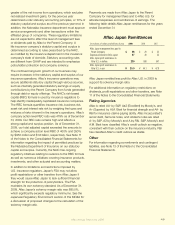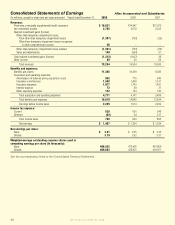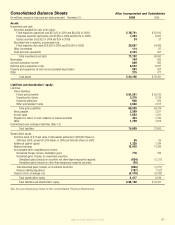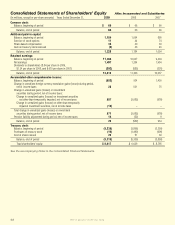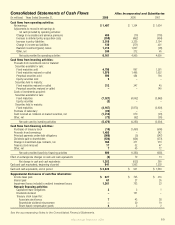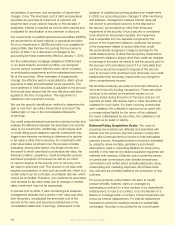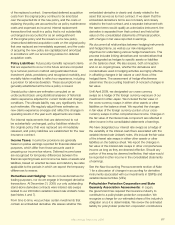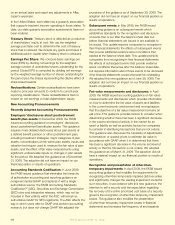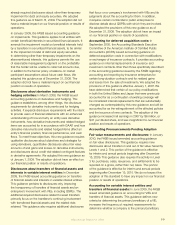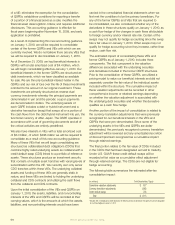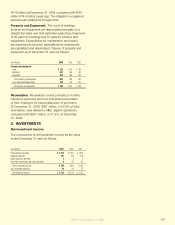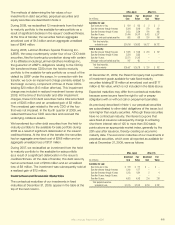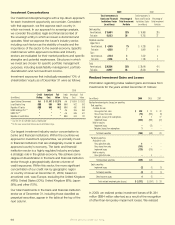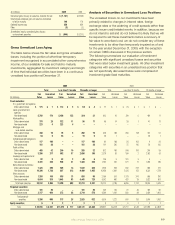Aflac 2009 Annual Report Download - page 63
Download and view the complete annual report
Please find page 63 of the 2009 Aflac annual report below. You can navigate through the pages in the report by either clicking on the pages listed below, or by using the keyword search tool below to find specific information within the annual report.
already required disclosures about other-than-temporary
impairment for debt and equity securities. We adopted
this guidance as of March 31, 2009. The adoption did not
have a material impact on our nancial position or results of
operations.
In January 2009, the FASB issued accounting guidance
on impairments. This guidance applies to all entities with
certain benecial interests in securitized nancial assets. It
amends the impairment model on benecial interests held
by a transferor in securitized nancial assets, to be similar
to the impairment model of debt and equity securities.
In determining other-than-temporary impairments on the
aforementioned interests, this guidance permits the use
of reasonable management judgment on the probability
that the holder will be unable to collect all amounts due,
in addition to the former policy of reliance on market
participant assumptions about future cash ows. We
adopted this guidance as of December 31, 2008. The
adoption did not have a material impact on our nancial
position or results of operations.
Disclosures about derivative instruments and
hedging activities: In March 2008, the FASB issued
accounting guidance on derivatives and hedging. This
guidance establishes, among other things, the disclosure
requirements for derivative instruments and for hedging
activities. It expands disclosure requirements with the intent
to provide users of nancial statements with an enhanced
understanding of how and why an entity uses derivative
instruments, how derivative instruments and related hedged
items are accounted for in accordance with GAAP, and how
derivative instruments and related hedged items affect an
entity’s nancial position, nancial performance, and cash
ows. To meet those objectives, this new guidance requires
qualitative disclosures about objectives and strategies for
using derivatives, quantitative disclosures about fair value
amounts of and gains and losses on derivative instruments,
and disclosures about credit-risk-related contingent features
in derivative agreements. We adopted this new guidance as
of January 1, 2009. The adoption did not have an effect on
our nancial position or results of operations.
Disclosures about transfers of nancial assets and
interests in variable interest entities: In December
2008, the FASB issued accounting guidance on transfers
of nancial assets and interests in variable interest entities.
This guidance pertains to disclosures only, improving
the transparency of transfers of nancial assets and an
enterprise’s involvement with VIEs, including QSPEs. The
additional required disclosures related to asset transfers
primarily focus on the transferor’s continuing involvement
with transferred nancial assets and the related risks
retained. This guidance also requires additional disclosures
that focus on a company’s involvement with VIEs and its
judgments about the accounting for them. In addition,
it requires certain nontransferor public enterprises to
disclose details about QSPEs with which they are involved.
We adopted the provisions of this new guidance as of
December 31, 2008. The adoption did not have an impact
on our nancial position or results of operations.
Accounting for deferred acquisition costs: In
September 2005, the Accounting Standards Executive
Committee of the American Institute of Certied Public
Accountants (AICPA) issued accounting guidance on
deferred acquisition costs in connection with modications
or exchanges of insurance contracts. It provides accounting
guidance on internal replacements of insurance and
investment contracts other than those specically described
in the accounting guidance issued by the FASB regarding
accounting and reporting by insurance enterprises for
certain long-duration contracts and for realized gains
and losses from the sale of investments. We adopted the
provisions of this guidance effective January 1, 2007. We
have determined that certain of our policy modications
in both the United States and Japan that were previously
accounted for as a continuation of existing coverage will
be considered internal replacements that are substantially
changed as contemplated by this new guidance and will be
accounted for as the extinguishment of the affected policies
and the issuance of new contracts. The adoption of this
guidance increased net earnings in 2007 by $6 million, or
$.01 per diluted share, and was insignicant to our nancial
position and results of operations.
Accounting Pronouncements Pending Adoption
Fair value measurements and disclosures: In January
2010, the FASB issued amended accounting guidance
on fair value disclosures. This guidance requires new
disclosures about transfers in and out of fair value hierarchy
Levels 1 and 2. This portion of the guidance is effective
for interim and annual periods beginning after December
15, 2009. This guidance also requires the activity in Level
3 for purchases, sales, issuances, and settlements to be
reported on a gross, rather than net, basis. This portion
of the guidance is effective for interim and annual periods
beginning after December 15, 2010. We do not expect the
adoption of this standard to have any impact on our nancial
position or results of operations.
Accounting for variable interest entities and
transfers of nancial assets: In June 2009, the FASB
issued amended guidance on accounting for VIEs and
transfers of nancial assets. This guidance denes new
criteria for determining the primary beneciary of a VIE;
increases the frequency of required reassessments to
determine whether a company is the primary beneciary
Aflac Annual Report for 2009 59


